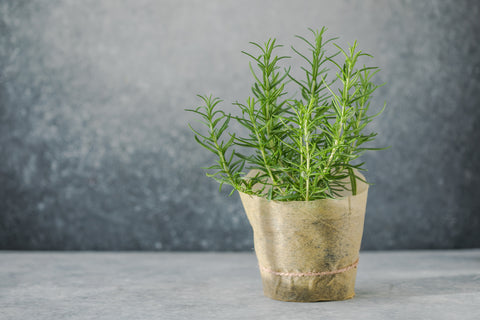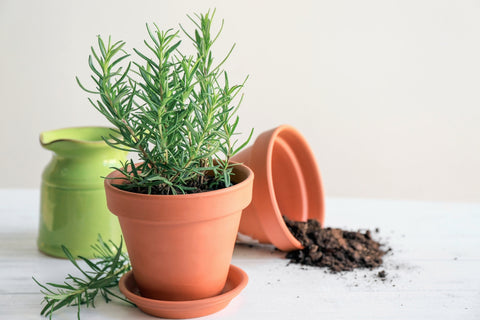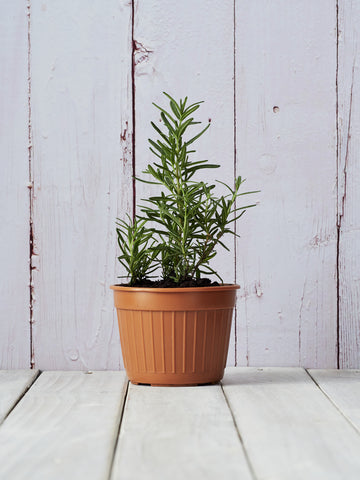Rosemary Plant | Rosemary Benefits, Uses, Growth and Maintenance Tips
Several aromatic plants are known for their healing and therapeutic impact on humans, so they are categorized under the herb category in the pure world of greenery. The rosemary plant is one such gracious herb that shoulders the responsibility of aiding people through its healing and aromatic properties. Let’s understand in detail the intricacies of growing this super-nourished herb in our home gardens!
What Is A Rosemary Plant?
The rosemary plant belongs to the herb family of Lamiaceae, where it is scientifically known as S. Rosmarinus; previously, it went by another binomial term called Rosmarinus Officinalis. The herb family Lamiaceae also gave membership to the sage plant and other medicinal green buddies. The plant was first discovered in the surreal landscapes of the Mediterranean, where it grew with a fibrous root system having evergreen needle-shaped leaves with tiny flowers shaded white to purple.

It fetches its name from the Latin word called ‘Ros Marinus,’ which means the dew of the sea. Rosemary is famous for its intricate ability to withstand droughts and cold temperatures. Although it can blossom with gorgeous blooms during Spring, the plant favors a warmer climate for a constant supply of enchanting flowers. Moreover, it dates back to ancient times around the fifth century BCE, the first usage of Egyptians for embalming corpses. In contemporary times, it is known for its generous healing capabilities and a fuss-free plant to grow in the Indian climate.
How To Care For A Rosemary Plant?
Known as Gulmehendi in our Hindi dialect, the rosemary plant stays lowkey throughout its lifespan. The best part about propagating rosemary in the kitchen garden is that it flourishes with minimal care and pure love. Here are all the details needed to grow it seamlessly in your home environment:
✦ Lighting Conditions
It is super easy to grow the rosemary plant in the home atmosphere by providing adequate sunshine. The plant demands a continuous supply of six to eight hours of sunlight. However, if the region stays too intensely lit by the mighty sun, then it is better to propagate the plant in a shaded spot outdoors or a bright spot indoors.
✦ Potting Mix
Rosemary prefers to stay in a drier environment, so it is best to propagate it in well-draining soil that is nourished organically through boosters like cocopeat, manure, bio-enzymes, charcoal, leaf molds, etc. One point to consider while potting it in a container is not to pick a container that is too large for the plant’s size; the larger the pot, the more the soil content, and the more the chances of rotten roots. Also, a perfect container choice for this plant would be the terracotta pots.
✦ Hydration Power
The most tricky point for growing most plants is nourishing them through optimal watering. The same goes for the rosemary plant, which is extremely particular about staying in a drier environment, probably because of its resistance to drought-like conditions. Water the plant with restricted hands only to moisten it enough for the day, then hydrate it again using a watering can when the soil has become completely dry. When the monsoons strike your door, ensure the plant is not kept at a spot where direct rains can hamper its well-being.
✦ Grooming Sessions
It is extremely important to trim rosemary plants because their leaves are used as a harvest. Moreover, when you cut the plant properly at regular intervals, it will pave the way for bushier growth with healthier leaflets. One can pick the leaves at any time for harvest, remembering that you don’t end up pruning more than one-third of its leaves. Plus, always make the cuts from the leaf joints whenever grooming the plant.

✦ Seeds & Cuttings
One can quickly grow the plant through seeds and cuttings as given further. When using rosemary seeds, ensure the seeds are sown in an indoor environment in seedling trays. You will soon catch the seedling trays sprouting with tiny rosemary leaflets; wait for them to grow up to five to six inches before shifting them in a bigger environment. Pick two inches long cuttings from a healthy plant and remove the bottommost leaves before placing the cuttings in a container. Settle the cuttings-induced container in a bright spot, and the plant will flourish as if new!
✦ Harvesting
It is super easy to harvest the rosemary plant by pruning its leaflets across the leaf joints. If you don’t wish to use the freshly harvested leaves, you can tie them up together and hang them in cool and dry stead to dry them for future usage. Once you catch the dried leaves, pick them out and store them in a mason jar for future utilization.
✦ Rosemary Issues
Although the plant requires minimal care and stays pretty fuss-free, it can sometimes get hijacked by nasty insects. The best solution lies in settling the plant in a full-sun environment where the soil can remain dry, saving the plant from insects and potentially rotten roots. If you still catch those nasty pests, bathe the plant under tap water and use a spray bottle loaded with neem oil to shield the plant even further.
What Are The Uses Of Rosemary Plants?
The rosemary plant is known in the gardening world for its inane capability to heal the human mind and body, which is why it is also considered one of the best in the medicinal world. Read further to know multiple rosemary plant uses:

➜ The plant is famous in the culinary industry for its aromatic flavor, so it is often used in curries, salads, marinades, breads, etc. Some chefs also prefer its fragrant taste and add it to cocktails for a unique and soothing flavor.
➜ Being a storehouse of essential minerals and vitamins like calcium, iron, vitamin C, vitamin A, and vitamin B-6, the plant has goodwill in the medicinal industry for its curing properties.
➜ People love the soothing fragrance of the rosemary plant, and so the plant is often seen in fragrant aromatic products like bathing essentials, bouquets, candles, scented sachets, and wreaths.
What Are The Benefits Of Rosemary Plants?
1. The rosemary plant is known to induce the mind muscles with positivity, thereby reducing stress and anxiety-causing hormones. The rosemary plant benefits people suffering from mental disorders, as it decreases cortisol while increasing dopamine. One can also go for rosemary oil therapy to decrease mental fatigue.
2. The plant is also considered beneficial for ingestion when someone goes through opioid withdrawal. It positively impacts the body by reducing the opioid withdrawal symptoms like muscle jerks, etc. However, we suggest you consult an expert before ingesting the plant.
3. The rosemary leaves benefit the mental power, so one gets a larger bandwidth for memory retention. It promotes better memory and focuses on everyone who makes it a part of their day-to-day lifestyle.

4. The plant is a healing agent for arthritis patients due to its anti-inflammatory properties. The beneficial qualities of the rosemary plant eradicate the mediators causing inflammation in the body, thereby treating and decreasing the chances of arthritis. It is also considered super impactful for treating gum inflammation.
5. If you ever go through a gastric issue and witness your digestive system struggling, the rosemary plant will rescue you. Drink a well-brewed rosemary tea to give your digestive system some relief.
6. The antioxidant and inflammatory properties of this healing herb pave the way for a well-functioning body with a healthy immune system, glowing skin, and reduced diabetic kidney issues. Rosemary benefits people who suffer from low blood pressure, which is why it is often advised that the plant should not be consumed by people with regular high blood pressure.
Conclusion:
The rosemary plant is a magical herb known from ancient times to heal the human body in more ways than one. It can be easily included in our kitchen herb gardens by seed and cutting propagations, and as mentioned earlier, it is super easy to grow and maintain. One can buy the rosemary plant from authentic gardening hubs like Plantlane at a decent price and enjoy the benefits of rosemary uses. So, what are you waiting for?

FAQs About Rosemary Plants In India
Ques: How To Take Care of Rosemary Plants Indoors?
Ans: The answer to how to care for indoor rosemary plants and how to care for rosemary plant outdoors is almost similar. The plant requires all the basic prerequisites like well-drained soil and optimal nourishment with appropriate watering cycles, the only difference being sun exposure. When outdoors, place it in a partially shaded spot, and when indoors, a brightly lit spot would be preferred.
Ques: What Is The Rosemary Plant Care In Winter?
Ans: The answer to how to care for indoor rosemary plants and how to care for rosemary plant outdoors is almost similar. The plant requires all the basic prerequisites like well-drained soil and optimal nourishment with appropriate watering cycles, the only difference being sun exposure. When outdoors, place it in a partially shaded spot, and when indoors, a brightly lit spot would be preferred.
Ques: What Are The Rosemary Plant Uses and Benefits?
Ans: The rosemary plant uses range from medicinal, culinary, and therapeutic. You can take the benefits of rosemary plant at home by ingesting it directly or infusing it in teas and oils. The plant has several anti-inflammatory and antioxidant properties that keep the body healthier and happier.
Ques: What Are Some Rosemary Plant Care Tips?
Ans: You should give the plant adequate sunshine of about six to eight hours without causing leaf burns. Further, choose a well-draining potting soil and hydrate the plant when the ground gets visibly dry. The rosemary plant care indoor includes placing the plant in a brightly lit spot.
Ques: Can I Purchase Rosemary Plants Online?
Ans: Yes, you can click on the rosemary plant buy option at Plantlane’s website to get the plant at a reasonable rate in India.


